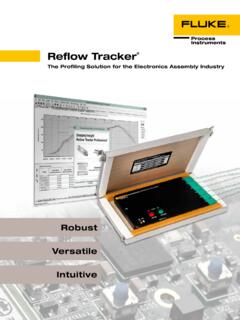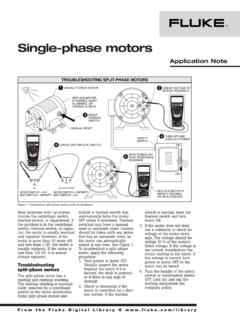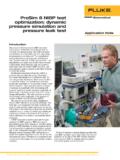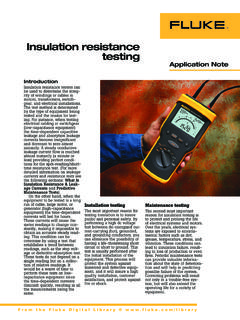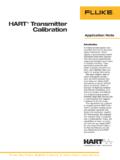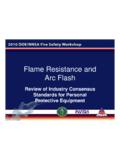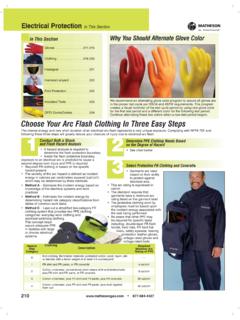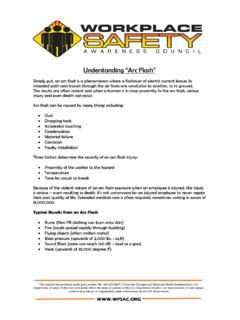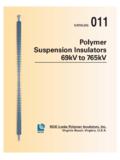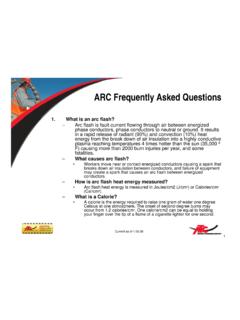Transcription of SAFETY CHECKLIST 10 dumb things smart people …
1 Replace the original fuse with a cheaper one. Digital multimeters (DMMs) that meet today s SAFETY stan- dards include a special high-energy fuse designed to pop before an over-load hits your hand. Fluke meters use a special sand-filled fuse designed to extinguish an arc within the fuse enclo-sure. Be sure to replace it with the same kind of authorized a bit of wire or metal to get around the fuse. That may seem like a quick fix if you re caught without an extra fuse, but it won t provide protec-tion against a spike headed your way. 10 dumb things smart people do when testing electricitySAFETY CHECKLISTW hile anyone who works with electricity quickly develops a healthy respect for anything that could possibly be live, even the best of us can make uncharacteristic mistakes when pushed for time.
2 The following is a quick list of WHAT NOT TO DO when taking electrical NOT:Use the wrong test tool for the job. Make sure your test tool holds the correct CAT rating for each job you do, even if it means switching DMMs throughout the day. (See Table 1)Grab the cheapest DMM on the rack. If that cheap test tool doesn t actually have the SAFETY features it advertised, you could end up a victim of a SAFETY accident. Look for independent labora-tory testing markings like CSA or UL that ensure the tool meets out on PPE. They re called SAFETY glasses for a reason. Take them out and put them on. The same goes for insulated tools, insulated gloves, ear plugs, your face shield/hood and arc-resistant on a live circuit.
3 De-energize the circuit whenever possible, and verify it s de-energized before start-ing work. If you have to work on a live circuit, make sure an arc flash risk assessment has been completed, use the NFPA 70E table (b) to select the appropriate PPE, and verify the opera-tion of your test tool by testing a known voltage source to follow lockout/tagout procedures. Lockout/tagout procedures exist to protect you from potentially fatal electric shock don t risk someone re-energizing your work environment. Review a sample lockout/tagout procedure from the Environmental SAFETY and Health Group of OSHA at while measuring.
4 When working with live circuits, try not to hold the meter in one hand while testing with the other in a transient situation, that could create a path to ground through your heart. Hang or rest the meter or use a wireless read-out to get the meter out of your hands and the readings at eye level, and use an alliga-tor clip for your ground, so that that you re only using one hand to probe the energized Fluke Corporation 10 dumb things smart people do when testing electricity6785!WARNINGArc Flash and Shock HazardAppropriate PPE RequiredBus: Panel H18 @ E4-4 Prot: X fmr XMSA-FUSEArc-Rated Clothing:Arc-Rated Shirt and Pants min 35 J/cm2 Arc-Rated Face Shield and Balaclava min 35 J/cm2 Flash Hazard inchesMin.
5 Arc cal/cm^2 Flash Protection inchesGlove Hazard when cover is VACL imited inchesRestricted inchesFlash ProtectionShock Protection 2015. Fluke Corporation. 6004960a-enDO NOT:Neglect test leads. Test leads are a critical component of DMM SAFETY . Make sure your leads match the CAT level of your job. Look for test leads with double insulation, shrouded input connectors, and test probes with finger guards and a non-slip surface. Test the leads with a known voltage before using. Consider leads with adjustable shrouds. There are even probes with built in fuses!10 Hang onto an old test tool forever. Today s test tools contain SAFETY fea-tures unheard of even a few years ago.
6 These features are worth the cost of an equipment upgrade and a lot less expensive than an emergency room visit. For example new standards restrict the length of metal in the tip of a test probe to 4mm or less in CATIII/IV 1. Measurement Categories IAW IEC/EN 61010-031 Measurement CategoryDescriptionExamplesCAT IVThree-phase at utility connection, any outdoor only by the utility transformer feeding the circuit.>>50 kA short circuit current. The origin of installation where low-voltage connection (service entrance cables) is made to utility power. Electricity meters, primary overcurrent protection equipment.
7 Outside and service entrance, service drop from pole to building, run between meter and panel. Overhead line to detached building, underground line to well IIIT hree-phase distribution, including single-phase commercial lighting.<50 kA short circuit current. Equipment in fixed installations, such as switchgear and polyphase motors. Bus and feeders in industrial plants. Feeders and short branch circuits, devices fed directly from distribution panels. Lighting systems in larger buildings. Appliance outlets with short connections to service IISingle-phase receptacle connected loads.<10 kA short circuit current.
8 Appliances, portable tools, and other household and similar loads. Outlet and long branch circuits. Outlets at more than 10 meters (30 feet) from CAT III source. Outlets at more than 20 meters (60 feet) from CAT IV NOT:3 Fluke Corporation 10 dumb things smart people do when testing electricityPersonal protective equipment categoriesAlways abide by the limits of use and minimum working distance.* The following PPE categories are described by the National Fire Protection Association (NFPA) Standard 70E. The greater the electrical hazard, the higher the personal protective equipment arc rating must be to withstand an arc-flash Category 1: Panelboards or other equipment rated 240 V ac and below Limits of use: Maximum 25 kA available short circuit current and 2 cycle ( sec) fault clearing time Minimum working distance: 18 inches (457 mm) Storage batteries, dc switchboards, and other dc supply sources 100 V dc to 250 V dc, short-circuit current < 4 kA 250 V dc to 600 V dc, short-circuit current of kA Maximum arc duration: 2 seconds Minimum working distance.
9 18 inches (457 mm)Arc-rated clothing, minimum arc rating of 4 cal/cm Arc-rated long-sleeve shirt and pants or arc-rated coverall Arc-rated face shield or arc flash suit hood Arc-rated jacket, parka, rainwear, or hard hat liner (as needed)Protective equipment Hard hat SAFETY glasses or SAFETY goggles (selection required) Hearing protection (ear canal inserts) Heavy duty leather gloves Leather footwear (as needed) No metal-framed eyeglasses, cell phones or radios, jewelry, rings, keys or watches Insulated hand toolsPPE Category 2: Panelboards or other equipment rated > 240 V ac to 600 V ac Other 600 V ac class (277 V through 600 V, nominal) equipment Limits of use: Maximum 25 kA available short circuit current and 2 cycle ( sec) fault clearing time Minimum working distance: 18 inches (457 mm) 600-VAC class motor control centers (MCCs) Limits of use: Maximum 65 kA available short circuit current and 2 cycle ( sec) fault clearing time Minimum working distance.
10 18 inches (457 mm) Storage batteries, dc switchboards, and other dc supply sources 100 V dc to 250 V dc, 4 kA <= short-circuit current < 7 kA 250 V dc to 600 V dc, kA <= short-circuit current < 3 kA Maximum arc duration: 2 seconds Minimum working distance: 18 inches (457 mm)Arc-rated clothing, minimum arc rating of 8 cal/cm Arc-rated long-sleeve shirt and pants or arc-rated coverall Arc-rated face shield or arc flash suit hood and arc-rated balaclava Arc-rated jacket, parka, rainwear, or hard hat liner (as needed)Protective equipment Hard hat SAFETY glasses or SAFETY goggles (selection required) Hearing protection (ear canal inserts)




